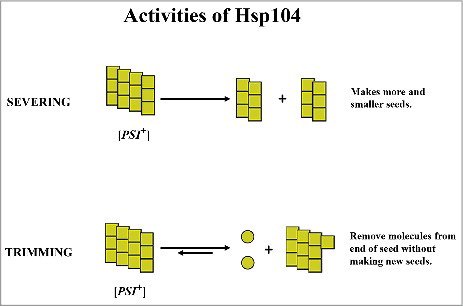Figures & data
Figure 1. Comparison of the kinetics of curing [PSI+] by inactivation of Hsp104 and overexpression of Hsp104. The rate of curing of the L2888[PSI+] variant was measured after inactivating Hsp104 with 5 mM guanidine (open circles) or overexpressing Hsp104 from the GAL1 promoter (closed circles).
![Figure 1. Comparison of the kinetics of curing [PSI+] by inactivation of Hsp104 and overexpression of Hsp104. The rate of curing of the L2888[PSI+] variant was measured after inactivating Hsp104 with 5 mM guanidine (open circles) or overexpressing Hsp104 from the GAL1 promoter (closed circles).](/cms/asset/6a2d6388-f779-4f8a-9744-c5bc06a2347d/kprn_a_1412911_f0001_b.gif)
Figure 3. Trimming of the GFP-labeled Sup35 foci in [PSI+] cells by overexpression of Hsp104. 1074 [PSI+] yeast, which expresses GFP-labeled Sup35 from the chromosomal SUP35 locus, was imaged prior to Hsp104 overexpression (panel a). Hsp104 was overexpressed for 1 generation using the tetracycline inducible expression system.[Citation12] Images were obtained before stress (panel b) and after stress (panel c). Maximized images of confocal Z-stacks obtained under the identical settings.
![Figure 3. Trimming of the GFP-labeled Sup35 foci in [PSI+] cells by overexpression of Hsp104. 1074 [PSI+] yeast, which expresses GFP-labeled Sup35 from the chromosomal SUP35 locus, was imaged prior to Hsp104 overexpression (panel a). Hsp104 was overexpressed for 1 generation using the tetracycline inducible expression system.[Citation12] Images were obtained before stress (panel b) and after stress (panel c). Maximized images of confocal Z-stacks obtained under the identical settings.](/cms/asset/9417c5b1-54a3-49ea-a7d9-6d59a5c7fb6d/kprn_a_1412911_f0003_b.gif)
Figure 4. Model of the curing of [PSI+] by Hsp104 overexpression. Curing occurs in a 2-step process with first trimming of the amyloid fiber followed by proteolysis of the amyloid core, consisting of small amyloid polymers. The rate of trimming (step 1) is increased by Hsp104 overexpression and decreased by Ssa1 overexpression. As for other factors that inhibit curing of [PSI+] by Hsp104 overexpression, including expressing Sis1 without its dimerization domain or deleting the following proteins: Sti1, Ssbs, or members of the Hsp90 family, it has yet to be determined which step is affected in this model.
![Figure 4. Model of the curing of [PSI+] by Hsp104 overexpression. Curing occurs in a 2-step process with first trimming of the amyloid fiber followed by proteolysis of the amyloid core, consisting of small amyloid polymers. The rate of trimming (step 1) is increased by Hsp104 overexpression and decreased by Ssa1 overexpression. As for other factors that inhibit curing of [PSI+] by Hsp104 overexpression, including expressing Sis1 without its dimerization domain or deleting the following proteins: Sti1, Ssbs, or members of the Hsp90 family, it has yet to be determined which step is affected in this model.](/cms/asset/b150b6f3-38e8-43bc-b55c-b6e632a88b1d/kprn_a_1412911_f0004_c.jpg)

